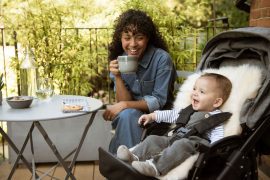3. Co-sleeping promotes breastfeeding
This proximity also supports breastfeeding. Not only is it practical for the mother to night-feed by simply rolling over and pulling her baby to her to feed (a huge help for c-section mamas!), the smell, movement and feeling of having her baby nearby sends cues to her body that promotes a healthy milk supply.
4. Co-sleeping promotes healthy sleep
Infants who sleep with their mothers and breastfeed spend more time in the lighter stages of sleep which is thought to be physiologically more natural and conductive to safe sleep for babies. It is easier to be aroused in these stages than in the deeper stages of sleep which can terminate apneas and potentially protect those babies born with arousal deficiencies. This is suspected to be a major component in SIDS. The natural movements of the mother during sleep combined with the scent of her milk are thought to keep the baby in the lighter stages of sleep for a longer period of time, allowing both mother and baby to get the sleep they need.
5. Co-sleeping promotes development
Many worry that once you start sleeping with your baby, you will continue this habit forever. Studies have shown that elevated levels of cortisol can actually cause social attachment disorders and the energy lost in crying could hinder growth and brain development. Babies who co-sleep are much less likely to cry themselves to sleep (or even at all!) and they can then focus their energy on physical and emotional development. It has been shown that by giving these babies the warmth and security that they crave, they often grow up to be less fearful and more independent children.
A NOTE ABOUT SAFETY
As both a postpartum doula and a sleep consultant, I find myself in a difficult position. The risks of bed-sharing are too great to ignore and I firmly stand by the AAP against it. That said, many parents (like me!) find themselves with babies who will only sleep with maternal contact and what is one to do? Paediatrician blogger Dr. Melissa Arca has, what I view as, the best expert advice I can find in her interview on The Science of Mom:
One thing parents should know is that bed-sharing cannot be an afterthought nor an act of desperation…this is very dangerous. Safe bed-sharing is really an overhaul of the whole sleep environment. You cannot simply take your baby and put him/her in your bed without any preparation. So parents really have to be committed to it and be willing to take the proper safety precautions.
If you are going to co-sleep with your newborn, there are certain guidelines to practise to be sure that you are not putting your little one in any danger. There are some really wonderful co-sleepers that provide a safe sleep environment for your little one while keeping them at arm’s reach to mama throughout the night.
If you are going to be bed-sharing with your little one, I urge you to follow La Leche League’s Safe Sleep Seven rules to make bed-sharing as safe as possible. Make sure that there are no loose blankets on the bed, that the bed is pushed flush up against the wall and that baby is not swaddled or dressed too warmly.
Everyone’s situation is different and there is no one sleep solution that works for every family. Co-sleeping can be a natural, comforting way to bond with your baby and promote healthy sleep habits. If it is practised safely and if it works for you, then it is right for your family!
Originally posted here
Originally from New York City, Sasha has lived throughout the United States, spent 15 years in Paris, France before moving to Singapore and is now settled in Munich, Germany. She had her first son in Paris and her second in Germany. Both of her boys hold two passports, speak three languages and have travelled the world with Sasha and her partner!
As an expat mom, Sasha understands the struggles that new moms face, whether you are surrounded by family or 6000 miles away from home! She believes that it is her role to provide you with evidence-based information and nurturing support to help you find the right path for your family.










